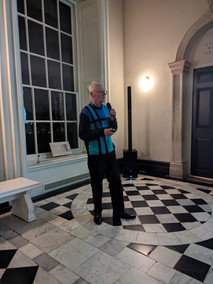How to Kill a Galaxy: Black Holes, Noisy Neighbours, and Cosmic Car Crashes by Dr Tim Davis
- Paul May
- Mar 14, 2024
- 3 min read
The host, Paul May, welcomed everyone to our new main lecture venue for the next year - the magnificent Great Hall of Queens House. Not bad for temporary lodgings!

A close shave
Chris Sutcliffe opened proceedings with an amusing look at the sky in the coming month. February had seen some close asteroid approaches within the lunar orbit but we need to save the date for the next really close one - 14 Aug 2032. Mercury provides the most interesting planetary viewing being visible just after sunset. And with the approaching vernal equinox Leo makes it's welcome re-appearance with its associated galaxy cluster targets.

In the beginning....let there be light
Our speaker, Dr Tim Davis, started with the Big Bang 15 billion years ago. A second into the our universe's life it's boiling mass of elementary quark particles was starting to coalesce into baryons ie protons and neutrons. Three minutes in, and the first light elements were formed and three hundred thousand years later these ionic elements captured electrons to become neutral atoms. Photons could finally escape and we observe this snapshot of the early universe in the famous cosmic microwave background map.

This shows small variations in density - essentially amplified quantum fluctuations - but not enough to create the clumps of matter in today's universe. However, the map supports the current leading theory of a universe where baryonic mass only accounts for 5% of the universe's mass, with the rest composed of dark matter and dark energy. The dark matter does not interact with the hot particles but under gravitational forces forms a cosmic web that amplifies the small density variations. The intersections of this web become attractors of atomic matter, ie primordial gases. The first stars form within 100 million years and the first galaxies within 300 million years.
Murder most foul
Tim showed a brilliant simulation of how these initial galaxies are continually fed by gas to become ever larger. The problem is that this doesn't agree with observation. Although as amateur observational astronomers we like to focus on the photogenic spiral galaxies, the majority of the universes atomic matter is contained in dead elliptical galaxies. Why are galaxies not continually growing as in the simulation? The clue is in the correlation between the size of supermassive black holes (SMBH) that lie at the centre of most galaxies and the total mass of those galaxies. As the SMBH only impacts it's immediate vicinity, this makes no apparent sense.

Nothing in his life became him like the leaving it
Black holes. The answer appears to be in the extremely energetic jets that are thrown out by the interaction of black holes with their accretion disks. These contain so much energy that they can prevent the continued growth of galaxies.
Cosmic car crashes. Another violent galaxy death occurs when two galaxies collide. Although the existing stars in each galaxy largely pass through each other, the gas becomes concentrated in the centre of the galaxies causing accelerated stellar formation in a starburst, but depleting the galaxy of gas for further expansion.
Noisy neighbours. Galaxies form in clusters and in this environment the gas feedstock of individual galaxies can be blown away by a gravitational driven stream of hot gases, effectively killing the galaxy by strangulation.
Thank you Tim for a fascinating cosmic whodunit, a veritable tour de force that took us from the birth pangs of the universe to the death throes of it's largest objects and all told with great enthusiasm and panache!










Comments